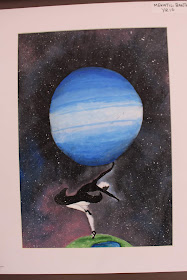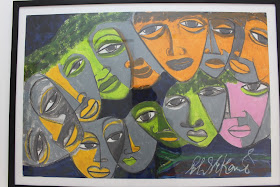BY
margaretta wa Gacheru (posted 16 june 2018)
Brookhouse
may be the most expensive private school in Kenya. But it’s also one that has a
tremendous appreciation for art and for teaching students to discover their creative
capacity through art.
The best
evidence of the value the school places on art education was apparent last
weekend (June 15th and 16th) when the art departments of
both Brookhouse schools organized a students’ Art Exhibition at Village Market
right next to the main entrance.
None of the
artworks were for sale. “That was the arrangement we made with the management,”
explains Lindy Nyaseme, the Head art teacher at Brookhouse’s main campus in
Karen. But that issue didn’t bother these young artists, some as young as five,
others as old as 17. They are just pleased to have their artworks selected to
be in the exhibition and to be having the first public display of their art.
Among the
artworks exhibited were paintings, prints, photographs and one sculpture that
looked it might have been inspired by either Leonardo Di Vinci or Alberto
Giacometti or both.
What’s most
appealing to me about the Brookhouse approach is that unlike the Kenyan system
which functions of the facile position that art isn’t important, this school
finds art to be integral to a child’s early education.
“From
pre-primary all the way up, we teach every [grade level] student art twice a
week, and for one hour every session,” says Lisa Bagot, an art teacher at the
original Brookhouse campus in Karen.
by Amai Malong, age 5
Then she adds that children can also major in it for their A-level equivalent, and even two years before that begins, they can focus on it. Then too there’s another A level equivalent called BTEC which also has a fulltime focus on fine and applied art.
What was
exciting to see in the various displays of the children’s artworks was
discovering how proficient and passionate about art that they all seem to be.
Some of the most sophisticated works that I saw were photo-shopped images by
students like Roland Tegwa and Mehdi Nanji. Both created works that were highly
original and startling to the eye.
Mehdi had
created a lovely woman whose hair literally ‘stood on end’ even as it looked
spiked like a funky musician or a mad woman.
Meanwhile,
Ronald’s imaginative image sends out an apparent message -- that man might be
more animal than human. We know of course that man is both animal and human in
the best sense of the term. What isn’t immediately clear is that the animal
photo-shopped is a panda.
“The hardest
job was assembling the [partial] images to blend them together in a way that
was also balanced,” says Roland, who at 17 has just completed his A-levels and
wants to return to Brookhouse to take the BTEC course for an extra year,
eventually to become either a graphic or an interior designer.
One hardly
doubts that he’ll achieve his dreams, especially with teachers like his who are
fully invested in seeing him succeed.
What was
most impressive about the Brookhouse show is not just the quality of the works,
including that five-year-old’s colorful and well-proportioned painting.
It’s also
the teachers’ understanding that the work they do, promoting creativity as a
way of thinking, being and doing, is critical to shaping their students’
futures.
One only
wishes that school curriculum developers in Kenya would have a similar
commitment to including art as an examinable subject in the national syllabus
in a way that’s similar to what transpires at Brookhouse.
For one
doesn’t have to be rich to include teaching art in the classroom. Especially
when so many active Kenyan artists are currently focused on using local
materials and found objects to create fascinating works of art.
The contrast
between Brookhouse’s innovative approach to teaching art and Kenya’s antiseptic
approach to cutting out art education entirely is stunning and very sad.
There’s been a longstanding debate about the need to ‘decolonize’ Kenyans’
minds when it comes to many sphere of thought. But the debate has yet to heat
up related to the crying need to decolonize curriculum developers’ minds about
the value of creativity and the virtue of teaching art in Kenyan schools.
Up to now,
the most convincing argument put forward by Kenyan educationists in favor of
promoting creativity in education is economic. But creativity in itself needs
to be seen as the key to innovation, the attribute everyone says is what will
leapfrog Kenya into a productive future.














































